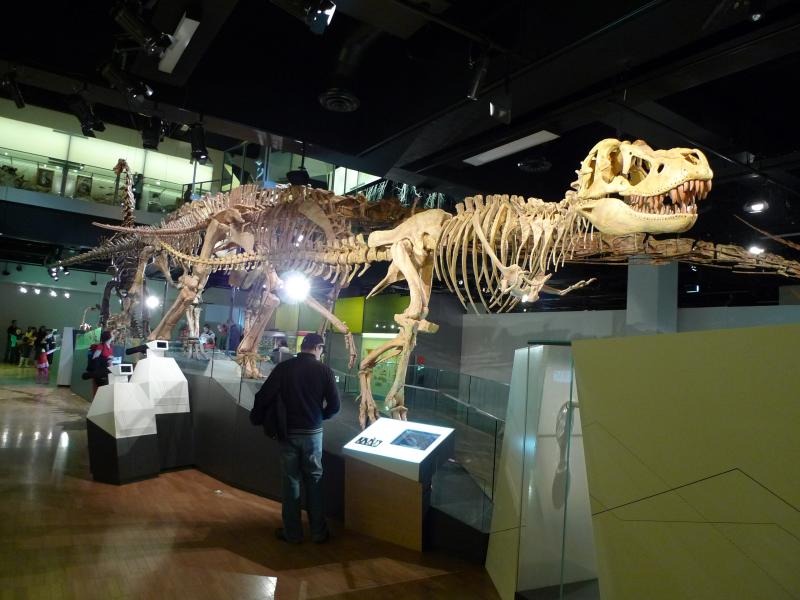
Dinosaurs are a surefire hit, but should all museums have them? (taken at Melbourne Museum)
Should museums and galleries always attract the largest and widest crowd possible, attracting/attacking every customer segment? Can they be scholastically superior, operationally efficient, highly entertaining, marketing savvy, and customer oriented at the same time? Are major blockbuster exhibitions the only way to draw a big crowd?
Some of these issues were tackled in this excellent post by Nina Simon (of Museums 2.0 blog) in an interview she conducted with John Falk and Beverly Sheppard, authors of the book "Thriving in the Knowledge Age: New Business Models for Museums and Other Cultural Institutions". Admittedly, I haven't read the book yet but I am definitely going to check it out.
As anybody working in the cultural industries would know, funding will always be a challenge for non-profits like us. There is an inherent market failure in artistic and cultural goods which needs to be addressed by the government through direct subvention, grants, or tax concessions. Even the mightiest institutions like the Smithsonian, Louvre, and British Museum depend on public and philanthropic funds to survive despite drawing in millions of visitors annually.
With a limit to one's resources, is it then reasonable to expect museums to stretch themselves as thinly as possible to cater to the widest socio-economic circle? Moreover, will focusing on big name shows end up diluting one's unique cultural identity and positioning?
Having spent some time researching and pondering the challenge of audience development in cultural institutions, I felt prompted to offer some views.
First, one should consider the raison detre of the museum or gallery. Many cultural institutions are public owned or public funded, and have a utilitarian obligation to serve the widest number. While eco-museums and community museums could narrow their focus around their regions or community groups, national museums and galleries have less flexibility to do so.
A possible solution is for cultural institutions to embrace a two-tiered or three-tiered approach. They could employ a primary strategy to address the needs of their main target groups - the segment that is most heavily represented or most significant to their mandate - and a secondary and tertiary strategy for other segments. While some may view such approaches as paying lip service to audience diversification, they may be the only feasible approach if funds are not forthcoming.
An example of this can be seen in science museums around the world. It is quite clear that the primary target of these institutions are school-going kids, especially those in their early teens and below. As such, the bulk of their resources - marketing, programming, education, exhibits - are channeled towards experiences specific to the interests of children. In order not to alienate other segments however, many science museums have a planetarium or omni-max theatre that can attract more mature visitors. They may also organise events like stargazing or documentary movie marathons (climate crisis extravaganzas anyone?) to draw special interest groups.
The important thing is to ensure that one's cultural brand is attractive, relevant and meaningful to a core group without alienating other segments.
Museums and galleries may also want to focus on where their core competencies lie and put the greatest emphasis on areas of strengths will yield the largest potential returns. This is the age-old 80/20 rule, which states that 80% of your results will come from 20% of your strategies. What are the unique areas of strength in your institution and how can you maximise them? What is the one or two thing that your institution has the best chance of being known for?
For example, younger institutions like those in Singapore may not have the breadth of collection comparable to museums like the Metropolitan Museum of Art or the American Museum of Natural History (featured in Night at the Museum). However, we can focus on specialising in niche collections - for instance, the Peranakan Museum having the best public collection of Peranakan artefacts - or in deploying technology to enhance the visiting experience. Such strategies may help museums and galleries to capitalise on the areas that they are good at, while still maintaining an acceptable standard in all the other areas.
Finally, I believe that there is still a time and place for blockbuster exhibitions in an institution's calendar. While some may see them as catalysts leading to the commodification of culture, they do perform a critical role in drawing new audiences who would otherwise not step into a museum. In a world fighting for the fast shrinking "attention resource" of the public, cultural institutions can ill afford to sit on their haunches and wait for visitors to trickle in.
To ensure that museums and galleries do not lose their cultural identities however, they can devise creative ways to link big-name shows to their own collections and programmes. This helps to endear visitors not only to that display of Egyptian Mummies or Chinese Terracotta Warriors for example, but to what their institutions possess that is culturally or historically linked to the objects. One can also conduct thematic tours that not only expound on those magnificent Impressionist Masters but weave in tasteful anecdotes of say Asian Impressionism which can be found in one's collection. The trick is to find links and connections with what one has and to bring them to the forefront.
In an ideal world, museums and galleries have infinite sums of money, occupy vast and sprawling buildings, and are as universally appealing as Disneyland. With limits to funding however, they need to focus on the few things which will yield them the greatest cultural and social dividends without compromising on their public missions. What I have just described however, may have just barely scratched the surface. The management of cultural institutions is an area that is highly complex and fraught with many bedeviling details.
I welcome your comments, criticisms and inputs!Labels: audience development, cultural institutions, galleries, marketing strategies, museums
